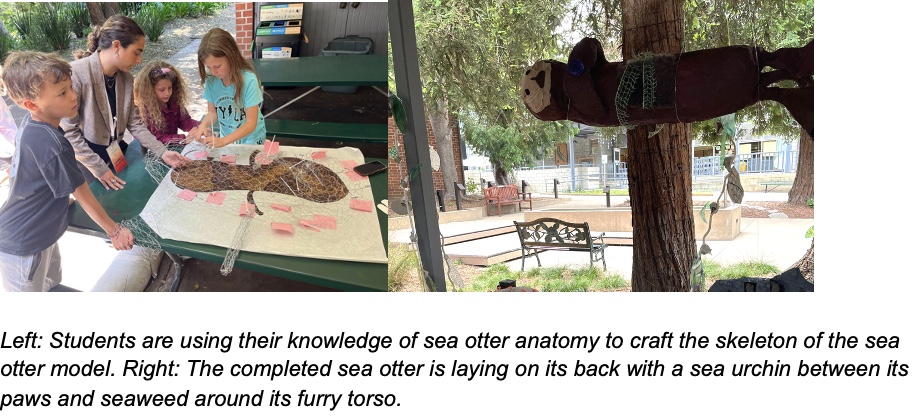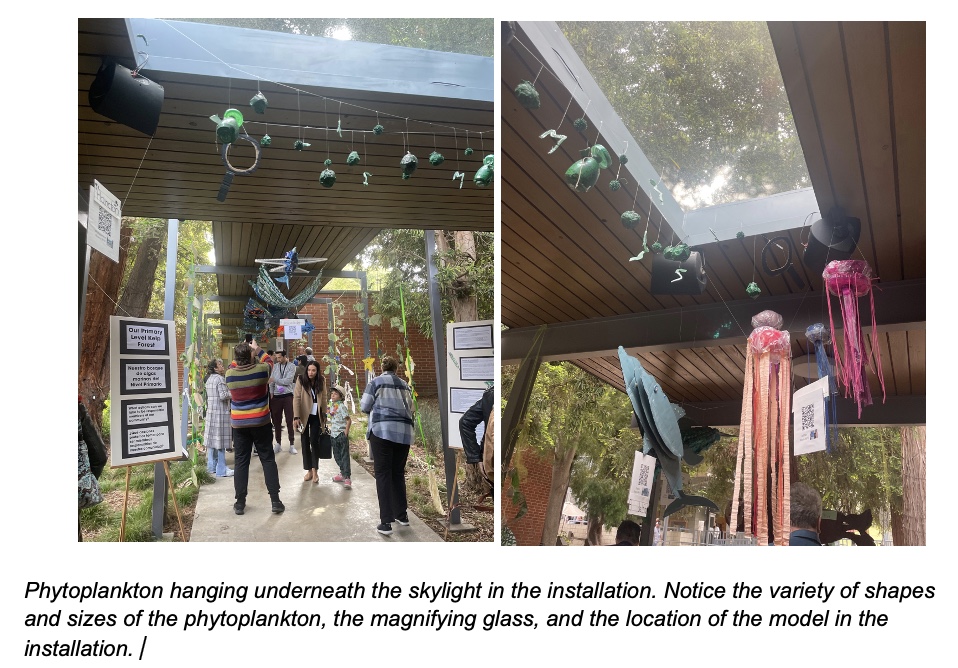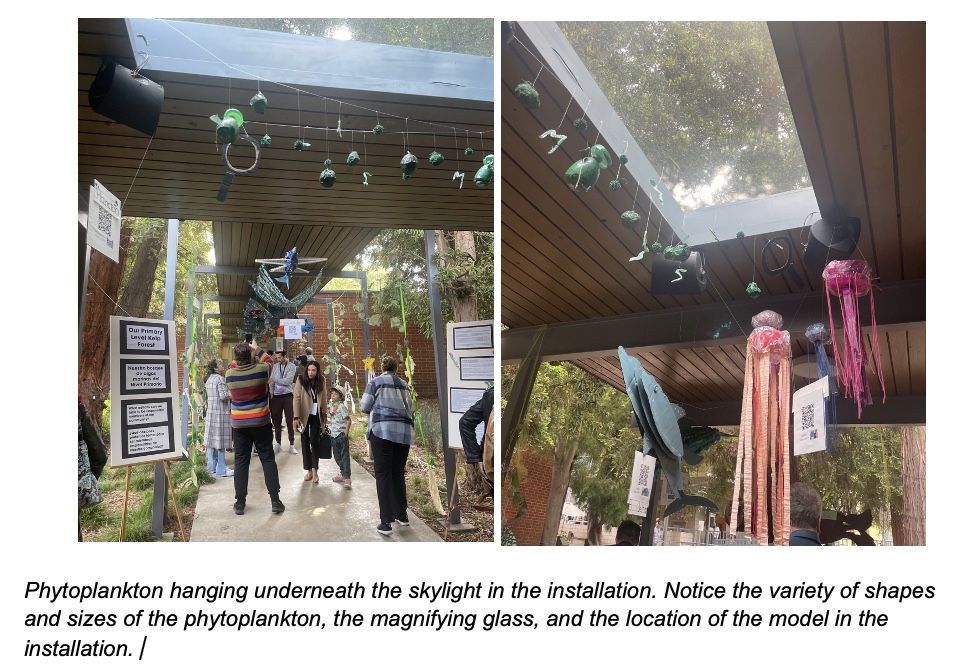Take a walk through the UCLA Lab School at the culmination of this school year and you will be transported into an underwater ecosystem. Primary students (1st and 2nd graders) have spent the past few months learning and creating an immersive kelp forest art installation. Blue waves float above your head and against the wall entangled with a variety of different types of kelp. It doesn’t take long to realize the species richness in this part of the school as you see a flying fish and seal hanging above and a garibaldi fish peeking from its cave.
The kelp forest installation at the Lab School is a remarkable collaborative project that has engaged primary students on an exploration of kelp forests. The installation, spanning across all six primary classrooms, showcases the creativity and knowledge the students have acquired throughout their deep dive into this marine ecosystem this past semester at school.
The creation of the installation began with the students immersing themselves in the world of kelp forests. They embarked on researching and investigating the kelp forest food web, visiting an aquarium to observe live kelp, reading books, and engaging in discussions about the various components and functions of this ecosystem.
Each primary classroom contributed to the installation, resulting in a comprehensive representation of a kelp forest. The students employed various artistic techniques and materials to construct different elements of the ecosystem. Each classroom also crafted their own interpretation of kelp using a variety of different materials, paying careful attention to the structure and appearance of the kelp. They also worked to create posters and videos advocating for the protection of marine ecosystems and emphasizing human impact. These videos were then placed around the installation as scannable QR codes detailing information about each organism and actionable steps to protect our ocean.
The process of creating the installation allowed the students to apply their scientific knowledge in an artistic context. They had to consider the relationships between different organisms within the ecosystem, the structures and functions of the animals they were representing, and the environmental factors that influence the kelp forest. The result was a visually appealing and scientifically accurate representation of this unique marine environment. Through the creation of the installation, the students developed their artistic skills, honed their understanding of scientific concepts, and cultivated their creativity and critical thinking.
Structure & Function in Students’ Artmaking
One remarkable aspect of the kelp forest installation is how the students incorporated their understanding of structure and function into their artistic creations. They demonstrated their knowledge of marine organisms by thoughtfully representing their physical attributes and behaviors, emphasizing the intricate relationships within the ecosystem. They did this by getting into small groups that focused on individual organisms from eels, leopard sharks, jellyfish, to phytoplankton. After careful research on the organism, students transformed their learning into making their art pieces.
For example, when crafting the sea otters, the students had many discussions around what position should the otter be in, how is it interacting with its environment, and what scale should everything be. To create the model, students considered the otters’ unique adaptations and behaviors. They considered the otters’ feeding habits and accurately decided to depict the otter laying on its back, munching on sea urchins. They paid special attention to the positioning of the sea urchin, keeping the soft side of the urchin close to the mouth. The inclusion of kelp wrapped around the otters highlights their use of the environment to anchor themselves while they sleep. The students even made sure to accurately depict details such as large webbed feet, smaller front paws, a strong tail, and closable nostrils, showcasing their precise understanding of otter anatomy.
In addition to larger marine animals, one student chose to explore the world of phytoplankton as her research organism. This presented a unique artistic challenge since phytoplankton are microscopic and cannot be seen by the naked eye. The student grappled with how to visualize something invisible without misleading the viewer. After contemplation, she decided to create magnifying glasses hanging near the phytoplankton, symbolizing their small scale in comparison to the rest of the exhibition. The placement of the phytoplankton near the skylight further emphasized their photosynthetic nature, connecting their role in the ecosystem to sunlight.
How Art Advocates for Social Action within Lab School Community Members
By delving into the intricacies of structure and function, the students were able to create meaningful representations that not only captured the essence of the organisms but also conveyed scientific concepts to the audience. Thus, students’ artistic choices were informed by their scientific understanding of the kelp forest ecosystem. This integration of art and science allowed the students to deepen their comprehension of the subject matter while unleashing their creativity.
Art has the power to go beyond aesthetic enjoyment and serve as a catalyst for social change. The creation of the kelp forest installation provided an opportunity for the students to delve deeper into the importance of preserving marine ecosystems and the threats they face. Through their art-making process, the students not only learned about the scientific aspects of kelp forests but also developed a sense of empathy and responsibility towards the environment.
As part of the project, the entire Lab School community was invited to visit the installation and engage in discussions about the role of art in environmental advocacy. Parents, teachers, and fellow students were encouraged to reflect on the impact of human activities on marine life and talk about ways to contribute to conservation efforts. By sharing their knowledge and artistic interpretations, the students became ambassadors for the kelp forest ecosystem, inspiring others to take action and make environmentally conscious choices.
The Power of the Arts in Education
Throughout this quarter, I witnessed and learned about the powerful intersection of art and education. Students not only gained a deep understanding of kelp forests and marine life but also developed crucial skills such as critical thinking, creativity, and collaboration. They were able to explore topics such as complex food webs and keystone species, different animal adaptations to their environment, how humans impact that environment, and the interdependence of it all.
Art provided a means for the students to express their scientific understanding, bringing the intricate details of the kelp forest ecosystem to life. The process of creating the artwork allowed them to make connections between art and science, reinforcing the idea that these disciplines are intertwined and can enhance one another. Moreover, it fostered a sense of environmental stewardship, empowering students to raise awareness about the importance of preserving our natural resources and inspiring others to take part in conservation efforts. By embracing art as a tool for learning and advocacy, students demonstrated the transformative power of creativity and its ability to shape young minds and inspire positive change. The kelp forest art installation stands as a testament to their passion, knowledge, and commitment to making a difference in the world around them.




